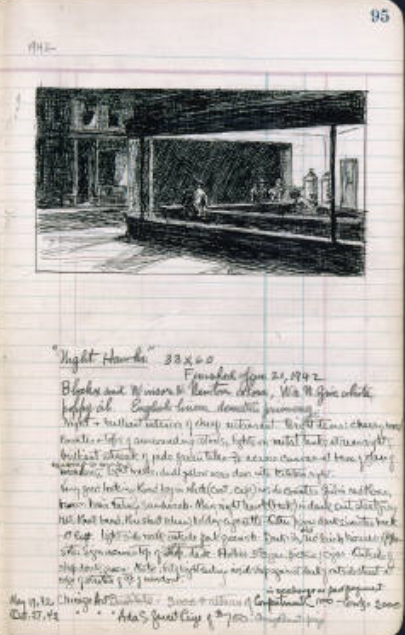Edward Hopper’s Village


I was enthralled while perusing the Whitney’s current exhibit Modern Life: Edward Hopper and His Time, on view through April 10th, which displays Hopper’s work alongside that of his contemporaries. The Whitney’s collection contains over 2,500 of Hopper’s works in addition to ledger notes kept by Hopper and his wife Jo. These notes provide details about each painting and have proven to be an invaluable resource to Hopper scholars.
Unfortunately, the ledger notes fail to give clues as to the whereabouts of the buildings shown in Early Sunday Morning and Nighthawks at the Diner, two of Hopper’s most iconic Greenwich Village scenes. Hopper did allude to possible sites in various interviews, alleging that the former was based on buildings on Seventh Avenue South and the latter on “a restaurant on Greenwich Avenue where two streets meet.” However, our own research has led us to believe that the artist may have relished being a touch misleading.
It seems more likely that Early Sunday morning was based on 233-237 Bleecker Street, a group of buildings for which GVSHP recently succeeded in securing landmark status as part of phase I of our proposed South Village Historic District. Seventh Avenue South was, after all, cut through older streets in 1917, so few of its buildings are as old as those portrayed in the painting (which are rich in 19th century details). As for Nighthawks, it seems increasingly evident that the subject was based an amalgam of several different restaurants around the Village, and that the diner in the painting existed only in Hopper’s mind. Our panel will delve more deeply into our theories behind each of these claims.

Edward and Jo Hopper’s charming studio on Washington Square North, which is now owned by NYU and houses much of the original equipment used by the artists, was featured on GVSHP’s Annual House Tour in May 2009. To purchase tickets to this year’s house tour or to become a volunteer docent, please visit our 2011 Benefit page.

Hi Elizabeth,
Great article. I really enjoyed reading it. Another excellent (three part) treatment of this subject was done last June by Jeremiah Moss on his blog Vanishing New York. It can be found at the link below.
http://vanishingnewyork.blogspot.com/2010/06/finding-nighthawks-part-1.html
Correction to my previous post. The Vanishing New York series was actually done in four parts… Pat
Thanks Patrick. We loved reading Jeremiah’s post. This whole mystery makes me glad, in a way, that Hopper refrained from being too forthright. It’s all so much more fun and interesting this way!
For “Early Sunday Morning” you should check out the City Winery building on Varick (South 7th Ave). Looks a lot like it to me.
Also, I’ve seen some convincing arguments that the Night Hawks location is on the corner of Greenwich Ave and 11th Street, right where they all collide with 7th Ave. It is the little flower shop. The tight angle is the same and the roof looks the same.
As to the real location of “Early Sunday Morning”, I can add a weighty speculation to the list. I lived and worked in the Chelsea Hotel from 1983 til 2006. During that time I became friends with a majority of the permanent residents, including Judith Childs, the wife and executor of the estate of her deceased husband, painter Bernard Childs (1910-1985), represented by the Jason McCoy Gallery on east 57th St. I Knew Bernard only shortly before he passed, but Judith and I are still in occasional contact. It was she who told me that Eward Hopper and Bernard were friends and that in fact, Hopper actually painted the work from the balcony of my apt. (just above the front entrance), of the row of buildings across 23rd. St.! The only feature still remaining is the fire hydrant! This makes logical visual sense too. If it was indeed early AM, the long shadows are accurately cast West from a low sun rising in the East.
Mrs. Childs is an intelligent, precise woman who would have no reason whatsoever to tell that unless it were true…I hope this clears the issue.